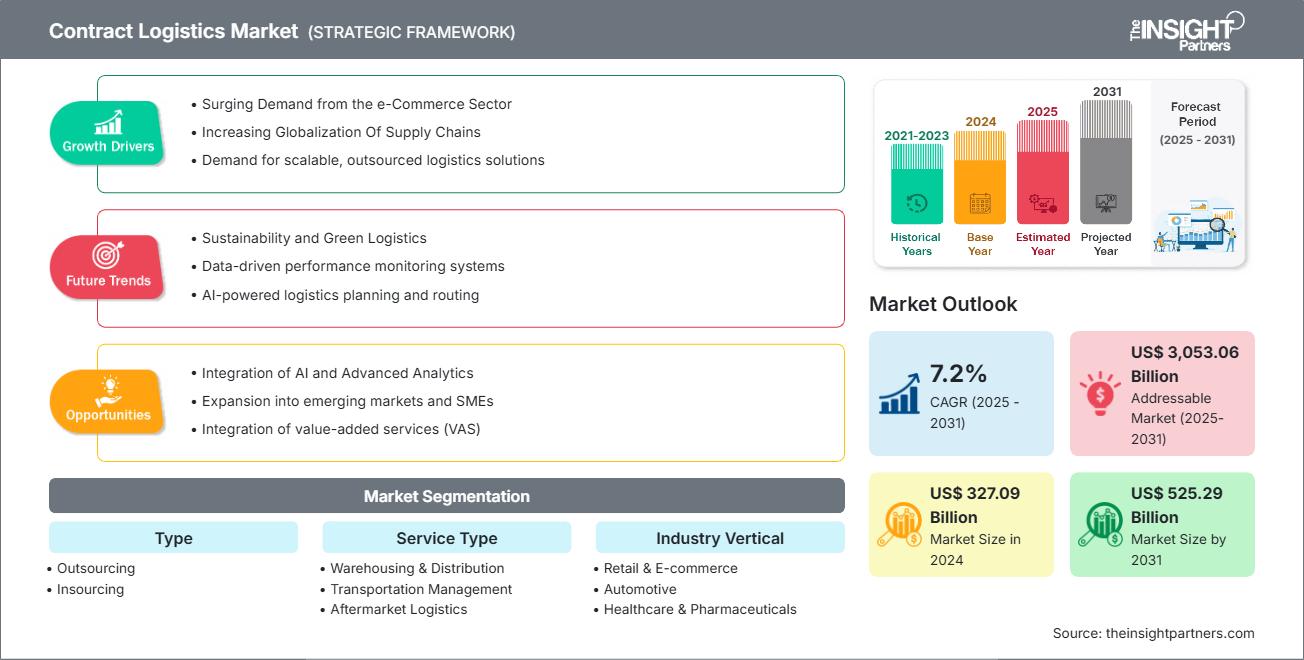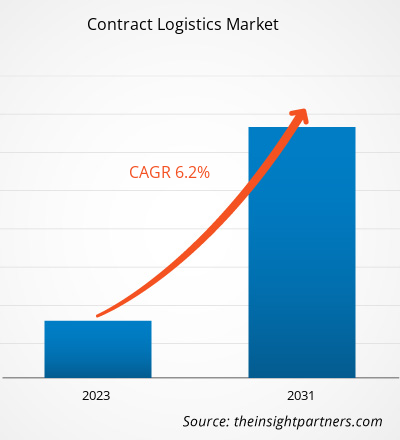合同物流市场规模预计将从 2024 年的 3270.9 亿美元增至 2031 年的 5252.9 亿美元。预计 2025 年至 2031 年期间该市场的复合年增长率将达到 7.2%。
合同物流市场分析
合同物流市场受到多个关键驱动因素的推动,包括电子商务的快速增长、对高效供应链解决方案日益增长的需求,以及贸易全球化对复杂物流网络的需求。自动化、物联网和人工智能等技术进步提高了物流运营的可视性、速度和准确性,创造了巨大的增长机会。此外,企业越来越注重可持续性,促使物流供应商采取绿色举措,拓展市场潜力。
合同物流市场概况
合同物流是指将物流和供应链管理服务外包给第三方供应商,由其代表客户管理仓储、运输、库存控制和配送。这种模式使企业能够专注于核心竞争力,同时受益于成本效益、更高的可扩展性以及先进的物流技术和专业知识。合同物流的常见应用包括订单履行、货运代理、逆向物流以及零售、制造、汽车、制药和电子商务领域的库存管理。合同物流服务的类型多种多样,从简单的运输和仓储解决方案到集成的端到端供应链管理,包括包装、组装和定制配送等增值服务。
您可以免费定制任何报告,包括本报告的部分内容、国家级分析、Excel 数据包,以及为初创企业和大学提供优惠和折扣
合同物流市场:战略洞察

-
获取此报告的顶级关键市场趋势。此免费样品将包括数据分析,从市场趋势到估计和预测。
合同物流市场驱动力和机遇
市场驱动因素:
-
电子商务领域需求激增:
电子商务的快速扩张极大地推动了合同物流市场的增长。随着越来越多的消费者转向在线购物,企业面临着对更快、更高效的配送和履行服务日益增长的需求。这种激增促使企业将其物流业务外包给专门管理供应链、仓储、运输和最后一英里配送的第三方供应商。电子商务在全球范围内扩张。例如,2023 年,印度电子商务格局取得了重大发展。开放数字商务网络 (ONDC) 在 11 月排灯节期间记录了近 120 万笔交易,反映出数字商务活动的激增。到 2023 年 12 月,ONDC 当月实现了 550 万笔交易,其中 210 万笔来自零售类别,表明数字平台的采用率正在不断提高。ONDC) recorded nearly 1.2 million transactions during Diwali week in November, reflecting a surge in digital commerce activities. By December 2023, ONDC achieved 5.5 million transactions in a month, with 2.1 million in the retail category, indicating a growing adoption of digital platforms.
-
供应链日益全球化:
供应链全球化的不断扩展是推动合同物流市场增长的关键因素。随着企业越来越多地在多个国家采购原材料和生产产品,管理这些分散运营的复杂性显著上升。全球市场之间日益增长的互联互通需要更高效、灵活和专业的物流解决方案。合同物流供应商在帮助企业应对与国际运输、海关法规和多样化分销网络相关的挑战方面发挥着关键作用。2023年6月,美国商务部成立了供应链竞争力咨询委员会 (ACSCC),召集官员和行业领袖共同探讨跨境物流协调、采购多元化和基础设施缺口等问题——所有这些关键因素都加剧了对外包物流能力的依赖。市场机会:
-
可持续性和绿色物流:
可持续性和绿色物流通过将供应链运营与环境和社会治理 (ESG) 目标相结合,为合同物流市场创造了巨大的机遇。随着全球企业面临越来越大的降低碳足迹和采取环保实践的压力,合同物流供应商不断创造创新解决方案,在提高运营效率的同时减少环境影响。这些绿色物流战略专注于减少排放、精简运输路线、提高仓库能源效率以及整合可再生能源。通过采用这些实践,企业能够为全球可持续发展目标做出贡献,并增强其长期韧性和竞争力。
合同物流市场报告细分分析
合同物流市场被划分为不同的细分市场,以便全面了解其结构、增长前景和新兴趋势。以下是大多数行业报告中使用的标准细分方法:
按类型:
-
外包:
合同物流外包是指公司将其供应链和物流运营(例如仓储、运输、库存管理和订单履行)委托给第三方物流 (3PL) 供应商。该领域在 2024 年占据了合同物流市场的最大份额。 -
内部采购:
合同物流内部承包是指将之前外包的物流业务转移回公司内部,以提升控制力、提高效率并提升服务定制化水平。随着企业在全球供应链中断的情况下寻求更大的灵活性,这一趋势正日益受到关注。
按服务类型:
-
仓储和配送:
仓储和配送是合同物流的核心组成部分,通过高效的库存管理和及时的产品运输,帮助企业简化供应链。2024年,该领域占据了合同物流市场的最大份额。
-
运输管理:
运输管理是合同物流的核心组成部分,旨在确保货物在供应链中高效、及时且经济地运输。它涉及路线规划、承运人选择、货运审计、货运追踪和绩效优化。 -
售后物流:
合同物流中的售后物流侧重于首次产品销售后的备件、退货、维修、回收或翻新所涉及的运输、管理和增值。 -
其他的:
在合同物流市场中,另一个服务类别包括包装、标签和货运代理等关键增值解决方案。
按行业垂直划分:
- 零售和电子商务
- 汽车
- 医疗保健和制药
- 消费品和电子产品
- 工业与制造业
- 航空航天与国防
- 其他的
按地域划分:
- 北美
- 欧洲
- 亚太地区
- 南美洲和中美洲
- 中东和非洲
亚太地区的合同物流市场预计将出现最快的增长。不断扩张的跨境电子商务行业是推动这一增长的主要动力。
合同物流市场区域洞察
Insight Partners 的分析师已详尽阐述了预测期内影响合同物流市场的区域趋势和因素。本节还讨论了北美、欧洲、亚太地区、中东和非洲以及南美和中美洲的合同物流市场细分和地域分布。
合同物流市场报告范围
| 报告属性 | 细节 |
|---|---|
| 2024年的市场规模 | 3270.9亿美元 |
| 2031年的市场规模 | 5252.9亿美元 |
| 全球复合年增长率(2025-2031) | 7.2% |
| 史料 | 2021-2023 |
| 预测期 | 2025-2031 |
| 涵盖的领域 |
按类型
|
| 覆盖地区和国家 |
北美
|
| 市场领导者和主要公司简介 |
|
合同物流市场参与者密度:了解其对业务动态的影响
合同物流市场正在快速增长,这得益于终端用户需求的不断增长,而这些需求的驱动因素包括消费者偏好的演变、技术进步以及对产品优势的认知度的提升。随着需求的增长,企业正在扩展产品线,不断创新以满足消费者需求,并抓住新兴趋势,从而进一步推动市场增长。

- 获取合同物流市场顶级关键参与者概览
合同物流市场份额(按地区)分析
预计未来几年亚太地区将实现最快的增长。南美、中美、中东和非洲等新兴市场也为合同物流供应商提供了许多尚未开发的扩张机会。
由于电子商务行业的兴起以及各国之间贸易的不断增长,各地区的合同物流市场增长情况各不相同。以下是各地区的市场份额和趋势摘要:
1. 北美
-
市场份额:
占据全球市场的很大份额 -
关键驱动因素:
- 在线零售的快速扩张需要高效的履行和最后一英里的物流。
- 自动化、机器人和仓库管理系统的集成。
- 公司越来越多地将物流外包,以专注于核心业务运营。
-
趋势:
3PL 和 4PL 合作伙伴关系的兴起,实现了端到端供应链的可视性和灵活性。
2.欧洲
-
市场份额:
很大一部分份额得益于早期严格的欧盟法规 -
关键驱动因素:
- 对跨多个国家的协调和合规物流的需求很高。
- 减少排放和采用绿色物流解决方案的压力。
- 专业物流服务需求旺盛。
-
趋势:
运输车队电气化和仓储中可持续包装的使用。
3. 亚太地区
-
市场份额:
增长最快、市场份额占主导地位的地区 -
关键驱动因素:
- 高产量需要可扩展的物流解决方案。
- 不断发展的电子商务生态系统,尤其是在印度、中国和东南亚。
- 对港口、高速公路和物流园区进行重大投资。
-
趋势:
支持混合零售模式的全渠道物流需求激增。
4.中东和非洲
-
市场份额:
尽管规模较小,但增长迅速 -
关键驱动因素:
- 零售和医疗保健等非石油行业的物流需求增加。
- 阿联酋、沙特阿拉伯和埃及等区域枢纽的增长。
- 简化法规以吸引全球物流参与者。
-
趋势:
与大型项目(例如 NEOM、DP World 扩建)相一致的物流中心的出现。
5.南美洲和中美洲
-
市场份额:
市场稳步增长 -
关键驱动因素:
- 南方共同市场和太平洋联盟国家的区域内贸易增加。
- 对冷链物流的需求。
- 城市化和零售业增长。
-
趋势:
通过移动平台和车队跟踪系统提高物流数字化。
合同物流市场参与者密度:了解其对业务动态的影响
市场密度高,竞争激烈
由于DHL供应链、XPO物流、DB Schenker和Kuehne + Nagel等大型全球性企业的竞争激烈,竞争也愈发激烈。此外,联邦快递(北美)、CEVA物流(法国)和日本通运(日本)等区域性和专业性供应商的加入,进一步加剧了竞争格局的多元化。
这种激烈的竞争促使公司通过提供以下产品脱颖而出:
- 集成供应链解决方案(例如仓储、最后一英里交付、库存管理)
- 仓库运营自动化和机器人技术的投资
- 开发特定行业的专业知识(例如制药、汽车、电子商务)
- 部署物联网、人工智能和实时可视化平台等先进技术。
机遇与战略举措
- 在仓储和库存管理中实施人工智能、物联网和自动化可以提高效率并减少人为错误。
- 数据分析和机器学习可用于需求预测、网络优化和预测性维护。
合同物流市场的主要公司有:
- 德国邮政股份公司(德国)
- 联邦快递公司(美国)
- GXO Logistics Inc.(美国)
- 联合包裹服务公司(美国)
- 日本通运株式会社(日本)
- GEODIS SA(法国)
- 莱德系统公司(美国)
- 法国达飞海运集团
- DSV AS(丹麦)
- 德迅国际股份公司(瑞士)
免责声明:以上列出的公司没有按照任何特定顺序排列。
研究过程中分析的其他公司:
- Expeditors International
- CH罗宾逊全球
- 雷诺斯物流
- 潘世奇物流
- 飞格物流
- 拓领全球物流
- APL物流
- GAC(海湾代理公司)
- 日邮物流
- 波洛莱物流
- 顺丰控股(顺丰速运)
- 德莎
- 拉本集团
- 货运合作伙伴
- 安德烈亚尼集团
- 仓库服务公司
- 国家粮食计划署
- Lineage Logistics
- TVS供应链解决方案
- Aramex
- 收费集团
- 德里维里
- 环球运输公司
- 吉布吕德·魏斯
- CMA CGM(合同物流部门)
- MSC(地中海航运公司)
- 温坎顿公司
- CJ物流
合同物流市场新闻和最新发展
-
DHL 集团已与 Temu 签署谅解备忘录 (MoU),2025 年 4 月 -
DHL集团与电商平台Temu签署了一份谅解备忘录(MoU),旨在深化合作,拓展双方成功的合作伙伴关系。该协议旨在加强合作,更好地支持本地中小企业(SME),无论是在成熟市场,还是在东欧和中东等新兴市场。 -
GXO Logistics, Inc. 扩大与 Revelyst 的合作伙伴关系,2025 年 4 月 -
全球最大的纯合同物流供应商GXO Logistics, Inc.(纽约证券交易所代码:GXO)宣布续签并扩大与Revelyst的合作伙伴关系。Revelyst旗下品牌致力于设计和制造高性能装备及精密技术,以提升户外体验。GXO将继续管理B2B和B2C物流服务,包括从其埃因霍温仓库提货、包装和退货管理。
合同物流市场报告范围和交付成果
《合同物流市场规模和预测(2021-2031)》报告对以下领域进行了详细的市场分析:
- 合同物流市场规模以及涵盖范围内所有关键细分市场的全球、区域和国家层面的预测
- 合同物流市场趋势以及市场动态,例如驱动因素、限制因素和关键机遇
- 详细的 PEST 和 SWOT 分析
- 合同物流市场分析涵盖主要市场趋势、全球和区域框架、主要参与者、法规和最新市场发展
- 行业格局和竞争分析,包括市场集中度、热图分析、知名参与者以及合同物流市场的最新发展
- 详细的公司简介
- 历史分析(2 年)、基准年、预测(7 年)及复合年增长率
- PEST和SWOT分析
- 市场规模、价值/数量 - 全球、区域、国家
- 行业和竞争格局
- Excel 数据集
近期报告
相关报告
客户评价
购买理由
- 明智的决策
- 了解市场动态
- 竞争分析
- 客户洞察
- 市场预测
- 风险规避
- 战略规划
- 投资论证
- 识别新兴市场
- 优化营销策略
- 提升运营效率
- 顺应监管趋势






















 获取免费样品 - 合同物流市场
获取免费样品 - 合同物流市场